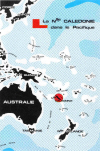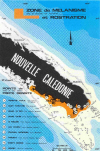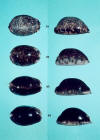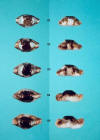| NIGEROSTRATION (Introduction) |
| THE NIGERS ROSTRATED (N/R or Nigerostration) PHENOMENON. |
| INTRODUCTION : |
The shell of Cypraeas, already very beautiful in a normal state, is really splendid at the stage Niger (Melanistique, or black), and/or Rostrated (Deformed, twisted). In the New Caledonian zone, one counted some 54 Species reached of Nigerisation (Melanisation, or Blackening) and/or Rostration (Deformation, lengthening, or thickening of the shell). Some of them become deformed without deterioration of their colors. Others blacken without modification of their shell. Sometimes, the 02 types are added simultaneously (Nigerostration), to form the most beautiful shells, consequently most required. The Melanistic and/or Rostrated Cowry (Called more commonly : Niger Rostrated (N/R), or more recently : "Nigerostrate(d)), presents certain differences in its state regarding to Normals Shells. The size is generally higher than the normal. The Melanism can go to the intense Black (As coal) granular (Hammering, as with facets), smooth (matte or gloss (Vernished)), or simply punctuated. The base may retain its color, become milky white or ivory-orange, remain normal or swelled. The extremities can rostrate sometimes spectacularly : the front will lengthen and curved to the bottom or top, the posterior rise or down turning right or left. Other cases reveal welded lips. For the very affected Specimens, with massive deformation and/or rostration very consequent, the structure even of nacre presents very many cracks, often invisible with the naked eye, but however revealed at the time of a catch of macro sight. Certain crackings are generally sometimes so deep that it can cause an even spontaneous accidental rupture of part of the shell, one or the other of its ends. This is why one can find splendid Specimens with a half rostre broken, even the both, while at the same time the animal is present.. With my opinion, the presence of these cracks indicates that the material nacrier or melanique contribution deposited by the animal during seasons, even in only once, must be done very quickly (Few seconds ?!), and harden quasi simultaneously, the final varnish perhaps being used as catalyst, or perhaps even the salt water itself. Cracks being, so probably a resultant of the internal stresses inherent in these rapids successive deposits, a little with the way in which certain artificial resins react during their polymerization. As inclusions (Earth, Gravels, or Coral) are sometimes visible as pearly and / or varnish layer, it is plausible that the contribution of nacreous secretions are added by Animal could be in a landfill complete or partial, directly into the ambient or occasional substrate. Better still, of the cavities or holes are put at the day during the breakage of one or the other of the ends. A water "bubble” it, in this case, was not "trapped” by this very fast polymerization of the material nacrier or melanique ?!. The coat of the Animal, when with him, progressively loses its texture with the development of the disease, a little as an anaemia for Human, with the proportions and profit, seems it, of the nacriers contributions. From colors sharp and opaque that it is usually for the majority of the Species, it becomes dull and almost translucent at a very advanced stage of its result. Thus, the coat of Cypraea Stolida alive at the Normal stage will be of texture with colourings sharp, opaque, and dense, hiding the drawings of the Shell completely. Contrary, that of Stolida alive at a advanced stage of Nigerisation and/or Rostration will have become dull, quasi translucent, and fine, letting perfectly appear by transparency the drawings and colors of the Shell. Currently still, it appears very difficult to determine a possible or probable maximum when at the ultimate stage which could reach one or the other of the Cowries Species touched by the aberrant Phenomenon, nor to affirm if the long currently known list will not be supplemented or will not decrease in the years to come. Fault of exhaustives serious Scientific studies in situ or in laboratory on the Subject, it would seem however certain that the Phenomena of Rostration, Melanisation, and Nigerisation/Melanisation would obey at 02 probable constants : - 01) : As regards the Geographical Situation of the zones concerned with this Phenomenon, it is curious to note that those are distributed along the Capricorn and Cancer Tropics, about at equal distances compared to Equator. Moreover, if Nigerisations remain unchanged in these zones, on the other hand, in the zones of Cancer Rostrations are often opposite of those of the Capricorn, and vice versa. Let us not forget that they are the secreting glands of Nacre and Melanine which “are put out of order”. It would thus seem that an important external Factor is blamed in the release of the “disease”. For my part, I would lean for a Factor related to the Terrestrial magnetism, completely likely to deteriorate the morphological functions of certain Shells, in the zones concerned. If an environmental Factor, like mining pollution, had been in question, all the Shells of all the varieties would be touched, and that everywhere, which is not the case, far is necessary some. It is, however, often seen in the affected areas, the presence of freshwater suspended, even in reef areas. - 02) : About the formation of the coachs of Nigerisations or Rostrations, a “Law of the seasons”, probably that of winter (June, July, and August), locally, is plausible. This fact is practically proven by certain Nigers found alive whose rostrations “clearly post” successive “layers” of nacre brought back the ones after the others. And that is even more remarkable on subjects found dead (Beaches) and/or degraded by time. Among the many shells affected by the Nigerostration, some, even different species, are of a quite remarkable common "peculiarity" : an "outgrowth" shell built by the Animal, from the base. - 03) : Currently, no one can / could say really : - A) : At what point in his life starts the phenomenon affecting the animal. - B) : If the formation of Nacre or Black seasons are consecutive, year after year, or rather staple, once the phenomenon started. - C) : What is actually the longevity of Cowries in the natural state, or the precise time on this subject. Then, when to find out how long live or survive the Cowries "nigers" and/or "Rostrated" once the Phenomenon started, nobody, in my opinion, will never able to bring lesser accuracy. As this phenomenon may well shorten this "life time" (As human Cancers like), or even the extended significantly, all likely rest !. - D) : Why some species are affected by the disease, and not others, all species combined. - E) : In marine areas recognized as capable of containing and Rostrated Nigers, areas of "specific" concentrations well differentiated are identified. - F) : Among them, no one can not explain why there are aberrant shells on a few square meters, while the substrate is exactly the same on hundreds of square meters area. - G) : Nor to tell why, in this same surface, only 01, or 02 or 03 species among dozens of other hereunder, are concerned by the problem. - H) : Nor determine why certain varieties rostrated only at their front extremities, others only at their rear extremities, and others, at their both exremities simultaneously. - I) : Nor discover why some species become never black, while surrounding the Nigerisation is paramount. - J) : Nor give explanations about the texture of the layers of Nigerisations, as it appears that there are several types of "natural" formation, namely : - The "Grainy" black (Chessmate or glossy).. - The "Paired" black (Chessmate or glossy). - The "Smooth" black (Chessmate or glossy). - The "Spotted" black (Chessmate or glossy). Some rarissims shells have so intense Black that they has bluish eye reflections under artificial light (Leds, notably !). - K) : Nor understand why for some shells, the Nigerisation begins by the dorsum of these, while for other the black is starting from the sides, back of base. That said, an interesting theory based from a few discoveries in-situ of other Gastropods appears credible. Indeed, it seems that some Gastropods enlarge their shells completely buried in the substrate around, or even the dark beneath rocks or corals. Why would it not same for training/growing Nigerisation and/or Rostration in the Cowries ?!. This would indeed explain some inclusions in the shell layers or melanistic. Moreover, with regard to certain inclusions of "air pockets under varnish", one can reasonably think that during a Parcel Post sent by plane, the “pressurization” encountered in the hold could very well make a micro-air bubble "burst" that must have been present "under" the varnish for ages, while it had remained invisible and completely undetectable before this air shipment, and thus make it apparent upon receipt of the package !. - L) : Recently, an interesting theory regarding Nigers and/or Rostrate eggs appear to explain the difference between 02 separate formations of Melanism or Rostration. Indeed, some shells build Black AND/OR Nacre after having reached adulthood, which could reasonably lead to think that they would be formed from eggs shells tell normals. - M) : By contrast, for shells (By as far as, the most spectacular !!) whose black and nacre are "blended" ("Mixed") to various degrees (Nigerostration), it can all also reasonably infer that it arose from birth to adulthood, and then continued. What is patent, however, is that many of the affected shells which were found dead are often dressed up of 02 simultaneous aberrations in exacerbated stage. Indeed, Rostration and Melanism stages would seem to have reached a degree paroxysmal for ultimate stage, perhaps cause of their effective mortality after a time unable to determine by the current state of the identified comments. - N) : It was often found clutches of Nigers and/or Rostrated clutches simultaneously by 02 or 03 aberrant shells of the Ssame species (Stolidas, between others !), as same as juvenile or subadult shells with black almost perfect (Mappas, Cribrarias, Mauritianas.). - O) : Some algae seem to indicate a more conducive to the Nigerostrees site : some say "crunchy and/or spicy" short, or long, more other "soft", moderately high, or even very high… - 04) : About the research of Nigers and/or Rostrated Cowries, better is worth to privilege the mode in night diving, which has the great advantage of nothing of disturbing in the natural fitting of the biotopes met. Indeed, it is enough to be trotted on the surface while sweeping the bottom with the spot light to see the shells sauntering outside their hiding-places with the favour of the night. Whenever possible, collections at low tides should be avoided as much as possible, simply because of the degradation instant occurring when lifting a block of coral. Even if the blocks are positioned back after being inspected, a simple exposure of a few seconds of the hidden face of these blocks, in the light of the day, is enough to destroy instantaneously all the micro-organisms which were hitherto safe from this one. Notice that as for my part, I use at the time of these night exits 02 types of material according to the duration or the zone of selected diving. Therefore, autonomous sophisticated equipment with lighting 4xLeds for a short duration, a major diving, or the prospection in rocks. Or else, a material sophisticated on battery of car with lighting 12xLeds for a much longer duration. These two materials having the enormous advantage of delivering very white light (Near to the diurnal light) uniform during several hours, stressing even less, if it were needed, the organizations lit by the beam. |
 |  |
 |
 |
 |  | /Xc-hNigMaterielLeds(Filaire)Pics/Xc-hNigMaterielLeds(Filaire)_small.jpg) | /Xc-iNigMaterielLeds(Portable)Pics/Xc-iNigMaterielLeds(Portable)_small.jpg) | |||||||||
| LOCATION (Geographical) | LOCATION (Territorial) | NIGERISATION (Only) | ROSTRATION (Only) | NIGEROS- TRATION | COLORS VARIATIONS | EQUIPMENT LED (Wired Projector) | EQUIPMENT LED (Portable Projector) | |||||||||
| (01) | (02) | (03) | (04) | (05) | (06) | (07) | (08) |